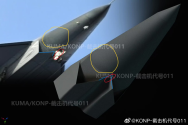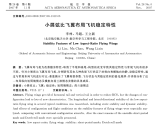KUMA from weibo took a stab at drawing the intake configuration based on the recent images. Perhaps the groove is a bit too deep though.
View attachment 150609
... not only perhaps! It is definitely too deep.
KUMA from weibo took a stab at drawing the intake configuration based on the recent images. Perhaps the groove is a bit too deep though.
View attachment 150609
The intake tip (blue lines) is wrong. The pretroding tip has an important purpose for the air flow management. The red circled area is where landing gear is, therefor the inlet tip can not extend that far and in that shape.KUMA from weibo took a stab at drawing the intake configuration based on the recent images. Perhaps the groove is a bit too deep though.
View attachment 150609

I think the fuselage is curving in more than the triangular inlet going out. Looking a bit like the Rafale intakes but more angular and without the boundary layer diverter fence. Boundary layer suction replace the fence.The intake tip (blue lines) is wrong. The pretroding tip has an important purpose for the air flow management. The red circled area is where landing gear is, therefor the inlet tip can not extend that far and in that shape.
I do agree with the depicition of the yellow circled area. It seems to be more of a curve than the area with holes (boundary layer suction) in the original photo. I guess it is still a DSI intake but very different arrangement from other DSIs that we have seen. The bump essentially morphed into the fuselage. I also remember reading paper saying that with increase of speed, the boundary layer will move along the axis of fuselage, therefor the inlet tip has to be moved longitudinally. If my guess work is right, this design could be optimized for a different operational speed range from existing 4th gen fighters, likely to the higher end.
View attachment 150649
I originally thought that without canards and with the main wing positioned very far back, the center of lift would also be far aft, causing a nose-down tendency. But judging from the deflection angle of the all-moving wingtips, they seem to be constantly pushing the nose down. Is it because the strake near the nose generates significant lift?
In one of the video the wing tip constantly flapping though.I originally thought that without canards and with the main wing positioned very far back, the center of lift would also be far aft, causing a nose-down tendency. But judging from the deflection angle of the all-moving wingtips, they seem to be constantly pushing the nose down. Is it because the strake near the nose generates significant lift?
I originally thought that without canards and with the main wing positioned very far back, the center of lift would also be far aft, causing a nose-down tendency. But judging from the deflection angle of the all-moving wingtips, they seem to be constantly pushing the nose down.


Yes but more than that, the whole front fuselage generates significant lift as it is a lift body design. The nose is relatively longer than any other fighter jet in lift body design (J-20, J-35 and J-36), and the front fuselage is flatter too.Is it because the strake near the nose generates significant lift?
It has to constantly flap up and down because the whole design is more unstable in higher AOA.In one of the video the wing tip constantly flapping though.
Need more clear video instead of one still moment
I made a misstake about J-36 which also has two swept angles, it is just to a lesser extent.View attachment 150710View attachment 150709
Supersonic flywing design leads to lift center moving aftwards. It is less stable under higher AOA than lower AOA. The photos were taken during landing and takeoff, therefor high AOA, therefor wing-tip moving more "violently".
Yes but more than that, the whole front fuselage generates significant lift as it is a lift body design. The nose is relatively longer than any other fighter jet in lift body design (J-20, J-35 and J-36), and the front fuselage is flatter too.
[edit]
J-XDS is a flywing design of two swept angles instead of only one like B-2, B-21 and J-36, the front fuselage is part of the wing. It is more appropriate for us to drop the distinction betwen fuselage, main wing and strake etc.
Two-staged flying wing should be common in next-gen fighters. Single flying wings with large sweep angles drop like a rock at subsonic speeds, while small sweep angles crash into the sound barrier.I made a misstake about J-36 which also has two swept angles, it is just to a lesser extent.
